Anterior Deltoid Exercises
ADVICE FOR PATIENTS WITH MASSIVE ROTATOR CUFF TEARS
However there is another powerful muscle on the outside of your arm – the deltoid muscle – that may be re-educated to compensate for the torn rotator cuff.
The following exercises should be done three to five times a day to strengthen your deltoid muscle.It will reduce your pain and improve both the range of movement and your arm function.
These exercises must be done for at least 12 weeks and must always be performed starting lying down to begin with.
EXERCISES
1. While standing, bend forward and let your arm dangle free and perform gentle pendulum movement for about 5 minutes. This will help you in relieving pain and free up your muscles around he shoulder.
2. Lie down flat on your back, with a pillow supporting your head.
3. Raise your weak arm to 90 degrees vertical, using the stronger arm to assist if necessary. The elbow should be straight and in line with your ear.
4. Hold your arm in this upright position with its own strength.
5. Slowly with your fingers, wrist and elbow straight move the arm forwards and backwards in line with the outside of the leg, as per diagram (gentlemovement from both sides of the arm upright position.) Keep the movement smooth and continuous for 5 minutes or until fatigue.
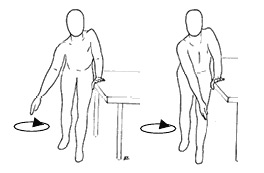
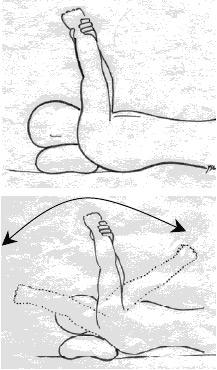
6. As you get more confidence in controlling your shoulder movement, gradually increase the amplitude of movement until your arm will move from the side of your thigh to above your head, touching the bed, and return.Keep the movement smooth and continuous for 5 minutes or until fatigue.
Keep the movement smooth and continuous for 5 minutes or until fatigue.
7. As you get more confidence in controlling your shoulder movement, a lightweight e.g. a tin of beans or small paperweight, should be held in the affected hand.Repeat as above (5 and 6).
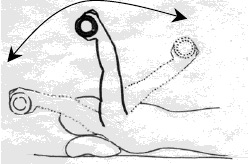
8. Having more confidence in controlling your shoulder movement gradually go from lying down to sitting and eventually standing. At this stage you may recline the head of your bed or put some pillows underneath your back to recline your position. Repeat the same exercise again, this time against some gravity. Start again from holding your arm in the upright position with its own strength. Repeat as above (5, 6, and 7).
Start first without any weights and progress to use the same lightweight you used before in the lying down position.
9. Another useful exercise for re-education of concentric contracture of the deltoid muscle.
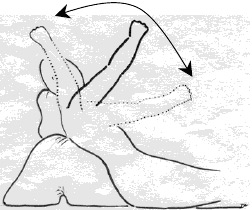
Performing the exercise
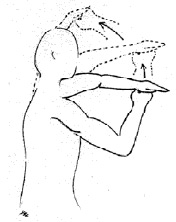
Make a fist with the hand of the affected side. The flat hand of the opposite side is providing resistance. Push your affected side hand against resistance from the other hand. While doing this, you will notice that you can fully elevate your arm (above your head). Repeat these exercises in order to ‘learn’ and re-educate your Deltoid muscle to perform this ‘concentric contracture’ even without pushing against your other arm. You should repeat these exercises X 10 in a session, 3 to 5 sessions per day.
10. Stop exercercising if your pain increases or you feel unwell.
Source: Ofer Levy, MD, Capio Reading Hospital, Reading, United Kingdom.

